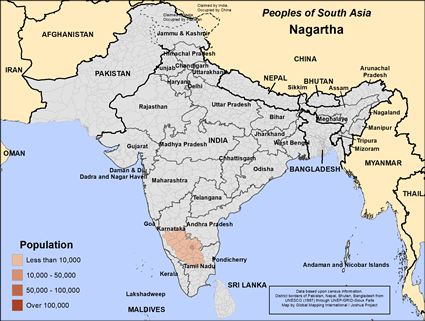Nagartha in India

Send Joshua Project a photo
of this people group. |

Map Source:
People Group data: Omid. Map geography: UNESCO / GMI. Map Design: Joshua Project.
|
| People Name: | Nagartha |
| Country: | India |
| 10/40 Window: | Yes |
| Population: | 55,000 |
| World Population: | 55,000 |
| Primary Language: | Kannada |
| Primary Religion: | Hinduism |
| Christian Adherents: | 0.00 % |
| Evangelicals: | 0.00 % |
| Scripture: | Complete Bible |
| Ministry Resources: | Yes |
| Jesus Film: | Yes |
| Audio Recordings: | Yes |
| People Cluster: | South Asia Hindu - other |
| Affinity Bloc: | South Asian Peoples |
| Progress Level: |
|
Introduction / History
The Nagartha people of southern India came originally from the northern Indian, specifically the ancient city of Ayodhya, the place Hindus believe is the birthplace of their god Rama. The Nagarthas were traditionally merchants, skilled artisans, moneylenders, and farm owners.
Where Are they Located?
The Nagartha people live in the south Indian states of Karnataka, Tamil Nadu and Andhra Pradesh.
What Are Their Lives Like?
Nagarthas are members of the third main caste of Hinduism, the Vaishya or merchant class. They are a forward (ie, privileged) class and therefore not eligible for India's affirmative action programs. They are mostly well educated and economically self-sufficient. Nagarthas encourage their children to obtain a college education.
What Are Their Beliefs?
The Nagartha practice Hinduism, the predominant, historic religion of India. One large group of Nagartha worship Vishnu, the preserver god while another main group worship Shiva, the destroyer god. They strive to follow the religious customs of the Brahmins, the highest and priestly caste of Hinduism. The Nagartha cremate their dead and have the unusual custom of carrying their dead in a blanket.
Prayer Points
Pray the Nagartha would find their true riches in the Lord Jesus Christ.
Pray the Lord would lead the Nagartha to hunger for and read the Bible. It is available in their three main languages.
Pray the Lord would raise up growing, Bible believing churches in the Nagartha community.